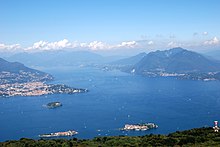House of Borromeo
The
The best known members of the family were the
History
Around 1300 this was one of a number of merchant families in San Miniato to carry the name "'Buon Romei'" (or 'Borromei') because of their origins in the city of Rome.[1]
The first member of the family to come to prominence was Filippo who, backed by Holy Roman Emperor

Filippo Buonromei married Talda di Tenda, sister of
Vitaliano Borromeo († 1449) had built a castle at Peschiera Borromeo near Milan in 1437. In 1450 Francesco I Sforza was backed by the family in his struggle to become heir and successor of the Visconti dukes and used the castle as a base for his siege of Milan. When he became duke, his gratitude for the family's services overwhelmed them with rewards and honours, among which was the title of a count of Peschiera for Vitaliano's son Filippo Borromeo (1419–1464) in 1461. Filippo expanded the bank as far as Bruges and London. The business was run at least until 1455.[4]
In 1520 Ludovico Borromeo built the castle Rocca Vitaliana at

The family has owned the Borromean Islands since the 16th century. The islands have beautiful gardens. Two of the islands have grand palaces, still owned by the family. Vitaliano Borromeo built a summer palace on the Isola Bella for his wife Isabella between 1650 and 1671 which was later enlarged by cardinal Giberto III. (1615–1672) and count Vitaliano VI. (1620–1690). Count Carlo IV. (1657–1734) had the garden terraces added. The family still owns the majority of the Borromean Islands.
The "State" of the Borromeo
Between the fourteenth century and the seventeenth century, the Borromeo were able to gain control of many fiefs in the
-
Castle Rocca di Angera
-
Palace on Isola Bella
-
Palace on Isola Madre
-
Castello Borromeo in Peschiera Borromeo
Cardinals
Seven cardinals of the Roman Catholic Church were members of the Borromeo family:
- Carlo Borromeo (St. Carlo), *1538 †1584
- Federico Borromeo, *1564 †1631
- Giberto III Borromeo, *1615 †1672[7]
- Federico Borromeo, *1617 †1673
- Giberto Bartolomeo Borromeo, *1671 †1740[8]
- Vitaliano Borromeo, *1720 †1793
- Edoardo Borromeo, *1822 †1881
-
St. Carlo
-
Federico
-
Giberto III
-
Federico
-
Giberto Bartolomeo
-
Vitaliano
-
Edoardo
Styles
- Count of Arona, by decree of the Duke of Milan dated 26 May 1446 for Vitaliano Vitaliani, adopted Borromeo (1390-1449).[9]
- Count of Peschiera in 1461 for Filippo Borromeo (1419–1464)
- Marquess of Angera, in 1623 by Philipp IV. of Spain for cardinal Federico Borromeo (1564-1631), confirmed in 1896 by the King of Italy for Conte Giberto Borromeo Arese
- Prince of Angera, in 1916 by the King of Italy for Conte Giberto Borromeo Arese (in Primogeniture)
Family members
- Vitaliano VI Borromeo (1620-1690), art collector
- Carlo IV Borromeo Arese, 15th Count of Arona, 5th Marquess of Angera (1657-1734), added his mother Giulia Viceroy of Naples and governor of the Holy Roman Emperor in the Kingdom of Italy
- Viceroy of Naplesand Minister plenipotentiary of the Austrian Netherlands.
- Giberto Borromeo Arese (1815-1885), painter
Current members
Current members include the daughters of Count Ferdinando Borromeo, a cadet son of Prince Vitaliano Borromeo. These are the four sisters:
- Lavinia Borromeo is the wife of Bilderberg Conferences.
- Fürstenberg.
- Isabella Borromeo is the wife of Ugo Brachetti Peretti, a manager (oil executive) from a noble family, son of Count Aldo Maria Brachetti Peretti.
- Princess Caroline of Hanover. Beatrice is a well-known political journalist in Italy.
Notes

- ^ "Home". borromeo.it.
- ^ "LagoMaggiore.Net - Hotel Alberghi Campeggi sul Lago Maggiore". www.lagomaggiore.net.
- ^ "Borromean Rings: Family Crest". Archived from the original on 21 April 2008.
- ^ "The Borromei Bank Research Project". Archived from the original on 7 April 2014. Retrieved 7 April 2014.
- ^ Pietro Canetta, La famiglia Borromeo, Tamburini, Milano 1937.
- ^ AA. VV., Le Isole Borromee e la Rocca di Angera, pp. 152-157, Silvana, Milano 2011.
- ^ Florida International University, Biographical Dictionary section, Pope Innocent X (1644-1655), Consistory of February 19, 1652 (VI)
- ^ Florida International University, Biographical Dictionary section, Pope Clement XI (1700-1721), Consistory of March 15, 1717 (XII)
- ^ Count of Arona[permanent dead link], decree of the Duke of Milan dated 26 May 1446
References
Further reading
- www.borromeo.it: A Borromeo Family website. (in Italian)
- www.peschieraborromeo.com, Il Castello di Peschiera Borromeo (in Italian)
- Borromeo Genealogy at sardimpex.com[permanent dead link]
- Borromeo Turismo
- The Borromeo Family of Cebu











